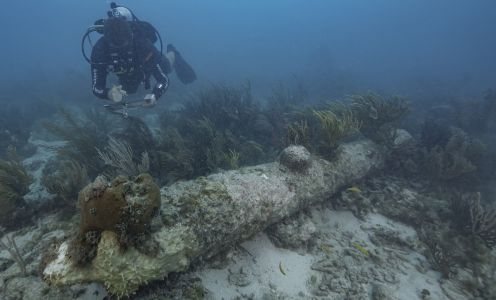
A National Park Service diver documents one of five coral-encrusted cannons found during a recent archeological survey in Dry Tortugas National Park. NPS Photo by Brett Seymour
Last week, the National Park Service announced that its archeologists have identified the remains of HMS Tyger, an 18th-century British warship, within the boundaries of Dry Tortugas National Park, off the south coast of Florida. Built in 1647, the fourth-rate, 50-gun frigate sunk in 1742 after it ran aground on the reefs of the Dry Tortugas while on patrol in the War of Jenkins Ear between Britain and Spain. The remains of the historic shipwreck were first located in 1993, but now new research has uncovered definitive evidence of the identity of the sunken ship.
From the National Park Service press release:
Using leads from historical research, archeologists from Dry Tortugas National Park, the Submerged Resources Center, and the Southeast Archeological Center surveyed the site in 2021 and found five cannons approximately 500 yards from the main wreck site. Buried in the margins of the old logbooks was a reference that described how the crew “lightened her forward” after initially running aground, briefly refloating the vessel and then sinking in shallow water.
Based on their size, features and location, the guns were determined to be British six and nine-pound cannons thrown overboard when HMS Tyger first ran aground. This discovery and reevaluation of the site led archeologists to make a sound argument that the wreck first located in 1993 was in fact the remains of HMS Tyger. The findings were recently published in the International Journal of Nautical Archaeology.
“Archeological finds are exciting, but connecting those finds to the historical record helps us tell the stories of the people that came before us and the events they experienced,” said Park Manager James Crutchfield. “This particular story is one of perseverance and survival. National parks help to protect these untold stories as they come to light.”
After HMS Tyger wrecked, the approximately 300 members of the crew endured 66 days marooned on what is today Garden Key. They erected the first fortifications on the island, more than 100 years before Fort Jefferson, which now dominates the island and is the principal cultural resource within the park.
The stranded survivors battled heat, mosquitoes and thirst while attempting to escape the deserted island. They built vessels from salvaged pieces of the wrecked HMS Tyger and made several attempts to seek help, gather additional supplies and locate Spanish naval vessels in the area. After a failed attack on a Spanish vessel, the surviving crew burned the remains of Tyger to ensure its guns did not fall into enemy hands and used their makeshift vessels to make a 700-mile (1,125 km) escape through enemy waters to Port Royal, Jamaica.
While the site is routinely monitored and currently protected under cultural resource laws applicable to other sites within Dry Tortugas National Park, positive identification of HMS Tyger as a British naval vessel offers additional protection under the Sunken Military Craft Act of 2004. The remains of HMS Tyger and its related artifacts are the sovereign property of the British Government in accordance with international treaty.
A similar warship, HMS Fowey, was lost in what is now Biscayne National Park in 1748 and is currently managed under a Memorandum of Agreement between the United States and the British Royal Navy.
“This discovery highlights the importance of preservation in place as future generations of archeologists, armed with more advanced technologies and research tools, are able to reexamine sites and make new discoveries,” said Josh Marano, the maritime archeologist who led the team that made the discovery.
March is Florida Archeology Month.
Thanks to Alaric Bond, David Rye and Andrew Reinbach for contributing to this post.

Subject of “The Master Shipwright’s Secrets” no less.